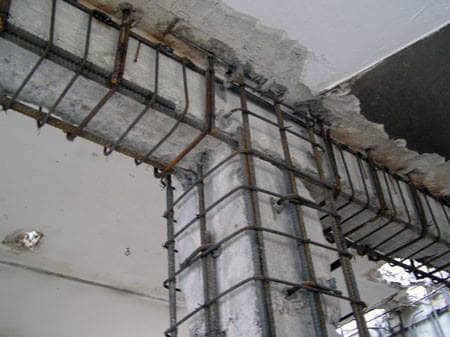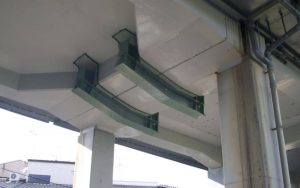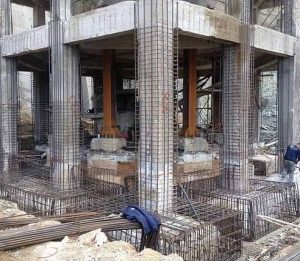Definition of Retrofitting
Retrofitting is the process by which we add new features to existing structures, such as heritage sites, older buildings, and bridges, etc. Retrofitting helps in reducing the vulnerability of damage to an
existing structure in case of any natural disaster or seismic activity.
What is Retrofitting?
Retrofitting is described as the procedure of change of existing structures such as Residential buildings, bridges, and historical buildings to make them impervious against seismic action like Earthquakes, Volcanic Eruptions, and other natural disasters that include landslides, tsunamis, floods, thunderstorms.
Retrofitting of RCC structural members is done so that the deteriorated concrete element structure regains its strength. It also helps to prevent further distress in concrete elements.
The deficiency in the strength of the concrete element could be because of design errors or poor workmanship. There could be another reason too for the deterioration such as the aggression of harmful agents.
Once the proper technique of retrofitting is implemented and specified, the required capacity to the structure could be regained and it totally depends on the severity of the damage caused.
There are various techniques that are used in the process of retrofitting such as external plate bonding, grouting, external post-tensioning, section enlargement, and fibre reinforced polymer composites.
The need for strengthening and repair of buildings and engineering works might arise once they are broken in such a way that they are not appropriate for general use. In such cases.
The structure cannot afford, with accepted reliability, a further sequence of the same action or other accidental actions and consequently, the chance of lives and therefore the risk of any structural and content damage would be unacceptable.
A strengthening change that can regain a sufficient level of safety and protection against such actions is described as retrofitting.
Also Read: Things to Know about Interlocking Bricks
Purpose of Retrofitting
As time passes many environmental factors going on around impact the structure. Out of all these factors, the most damaging is an earthquake that disturbs the internal structure of the building, and thus gradually building starts losing its strength and stability. As a result, the structure becomes unsafe for future use and might cause massive loss.
The level of deterioration caused to the concrete element structure is occurring at an alarming rate. It has been confirmed that even if all the specific building code is followed still there is a high risk of deterioration of concrete element and corrosion of reinforcement.
Steel corrosion is considered as one of the severe cause behind the deterioration of
reinforced concrete element and this could create cracks or reduce the effective area of the reinforcement, spalls the concrete cover, and might lead to collapse.
There are a variety of cases when dealing with damages. In case of any private or public sector like any office or house if the structure is damaged to an extreme level. Civil Engineers prefer demolishing the building and reconstruct it. But in the case of important and heritage buildings demolishing them is not an option. Now, here comes the phenomenon of Retrofitting.
Retrofitting has come to the frontline as a component of the drive to make structures warmer proficient and practical. This can help cut fossil fuel byproducts, make it less expensive and simpler to run structures, and can add to beating helpless ventilation and moist issues, therefore improving the whole situation. It can likewise expand building versatility, solidness, and flexibility.
Also Read: Complete Guide on Different Types of Roof Trusses
Importance of Retrofitting
Presently a-days retrofitting is extending its legs on the planet out of control, as a considerable lot of the recorded, public, and private significant designs get genuine old and become feeble because of passing time. Retrofitting is perhaps the most ideal alternative to make an existing lacking structure protected against future dangers or other natural powers.
Retrofitting is the cycle of expansion of new highlights to more established structures, legacy structures, spans, and so on Retrofitting diminishes the weakness of harm of an existing design during a not-so-distant future seismic movement.
It is the alteration of existing designs to make them more impervious to seismic activity, movement of the ground, and disappointment of soil because of seismic tremors or other characteristic cataclysms, for example, twisters, typhoons, and winds with high velocity caused by tempest, snowfall, hailstorms.
A few designs are significant considering public, social, or past significance. Retrofitting serves to enhance strength, resistivity.
Road Map to Retrofitting of Structure:
The basic objective behind retrofitting or repair works is to extend the service life, enhance the performance of the structure or increase the load-bearing capacity. The rational approach to any retrofitting work is to keep into consideration the main cause of the deterioration along with
the symptoms.
Only treating the symptoms without proper understanding of the main cause of the problems leads to camouflaged defects identification beneath the finished work. It is said that repair of the retrofitting
work should be avoided and for that, we need to follow the below-mentioned steps.
- Preparation of drawings and specifications
- Condition Evaluation
- Selection of materials and repair methods
- Determination of the main cause behind the deterioration
- Execution process
- Maintenance after completion of the retrofitting work
- Appropriate quality control measures
Also Read & Download: Project Report on Retrofitting of Building Construction
Problems that needs to be addressed
- Evaluation models and damage assessment
- Design and analysis of suitable repair methods and techniques
- Bridge rehabilitation
- Seismic retrofitting
- Strengthening and refurbishment techniques
- Materials for repair, protection, and rehabilitation
- Durability Considerations
- Performance monitoring and distress diagnostics, Non- Destructive test
- Structural Condition assessment
The two important methods of retrofitting that are carried out to improve concrete element structures are Strengthening of structural components and Surface repairs.
Under the Strengthening of the structural components, enlargement and composite construction is done whereas in Surface repairs spalling and disintegration along with the work to repair cracks is done.
Types and techniques of retrofitting
- Sealing with Epoxies
- Stitching
- Blanketing
- Routing and Sealing
- External Stressing
- Autogenous Healing
- Overlays
- Grouting
Sealing with Epoxies: Cracks in the concrete element could be sealed with the help of epoxy by injecting them with pressure.
Stitching: With the help of iron or steel dogs a cracked concrete part could be retrofitted by stitching in the same manner as we stitch clothes.
Blanketing: This technique of retrofitting is used on a large scale to seal the dormant as well as active cracks.
Routing and Sealing: Under this method of retrofitting the cracks along the affected surfaces are first enlarged and then a suitable material is used to seal them and fill them up such as Hot-Tar used on road pavements.
External Stressing: This process of retrofitting involves the process of counteracting the stress due to which the crack has been caused. It provides a residual compression and overcomes the tension, applied using rods and pressing wires.
Autogenous Healing: The unique ability of concrete elements to heal cracks by itself is known as Autogenous Healing. Basically used to seal dormant cracks such as cracks in water tanks or cracks caused due to temporary loading.
Overlays: These are types of retrofitting used to improve load-bearing capacity, drainage, rideability or to protect underlying concrete elements from aggressive environments.
Grouting: This process of retrofitting is similar to that of sealing with epoxies. It is basically a mortar paste that is mixed with adhesives to help increase the bonding properties.
There are two major strategies behind the retrofitting of structures, the first one is active strengthening and the second one is passive strengthening.
Active strengthening is a situation when additional deformation is not used and the repair done should be ready for immediate use.
In the case of passive strengthening, the repair work does not share a load by the time an additional load is applied.
Types of Retrofitting
There are following two types of retrofitting:
- Local Retrofitting
- Jacketing of beams
- jacketing of beam-column joints
- Strengthening individual footings
- Jacketing of Columns
- Global Retrofitting
- Adding shear wall
- Adding infill wall
- Mass Reduction
- Wall Thickening
- Adding Braces
Reinforced Concrete Structures
Two important methods that can be carried on improving concrete structures are these: –
- Adding New Structural Elements
- Strengthening Existing Elements
Masonry Structure
Other methods include Retrofitting through roofs, doors, and windows.
Advantages of Retrofitting
- Increases the life of the building.
- Is economical.
- It is pocket friendly
- Helps in increasing stability and sustainability
- Prepares the building to bear different weather conditions
- Helps in strengthening and enhancement of the structure.
Disadvantages of Retrofitting
- Small irresponsibility can cause further damage.
- Chances are that it can damage historical buildings.
- Need critical and expert analysis before Retrofitting.
- Requires expert analysis before proceeding to retrofit
- High risk of causing damage to Heritage Sites
- Normal negligence could cause major damage
- Manpower involved needs to be of good expertise.
Analysis of Retrofitting
Before applying any maintenance strategy, it is important to have an arranged way to analyze the state of cement and support.
This will require very specialized assessment and comprehension of the conduct of the primary buildings, which is being fixed. According to these analysis materials and method for retrofit is utilized.
This ensures safety. The choice to retrofit or supplant a construction or its segments can be chosen after the thought of administration life of designs that are set up dependent on the financial and specialized advancements.
Video on Seismic Retrofitting of RCC Structures
Still, Do Have a Question? Ask a Question and Get an Instant Answer






Leave a comment